Abstract
When cells of Escherichia coli ML30 were suspended in 2% gelatin and frozen at −40 C, no appreciable metabolic damage or death occurred. After freeze-drying for 8 hr at a platen temperature of 49 C and rehydration with a mineral salts medium, survival of the cells was 0.6%. Metabolic damage of the survivors was found to be 23%. Permeability alterations were detected by several criteria. Freeze-dried cells were susceptible to antibiotics normally ineffective against E. coli and leakage of ribonucleic acid (RNA) occurred. Analysis of ribosomal extracts of rehydrated freeze-dried cells demonstrated the presence of appreciable degradation products. Permeability alterations were shown to be reversible by the observation that antibiotic susceptibility was a time-dependent process and that the gratuitous inducer of β-galactosidase was not concentrated by freeze-dried cells until the injured cells had been incubated in a nutrient medium for 300 min or more. At approximately the same time, metabolic damage was repaired. RNA synthesis preceded protein synthesis by about 150 min, and deoxyribonucleic acid synthesis occurred with the resumption of normal growth. This was interpreted to be the result of repair of RNA taking place before protein synthesis and growth could resume. A pronounced increase in the lag time of freeze-dried cells was also observed. Peptides and Casamino Acids shortened the lag time for freeze-dried cells but not for the controls. Glycerol and glucose were found to be better carbon sources for growth of freeze-dried cells than sodium lactate or sodium succinate.
Full text
PDF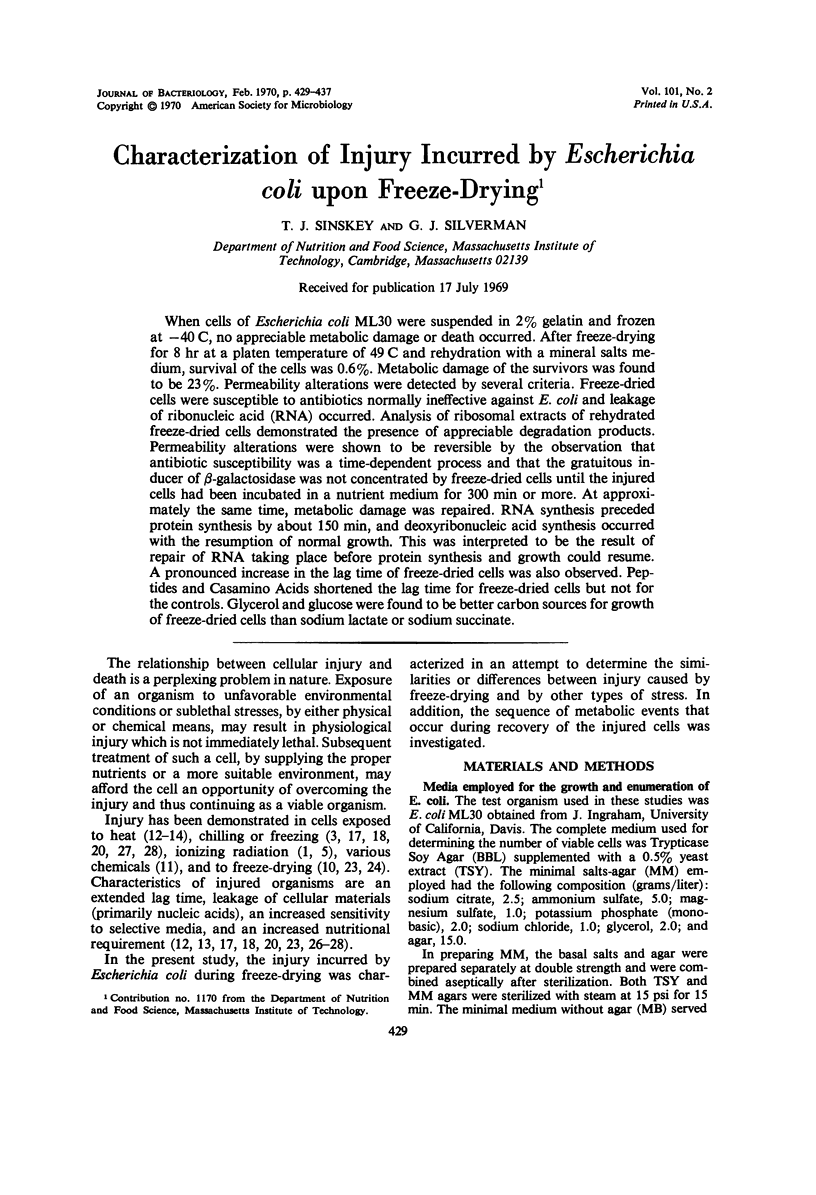

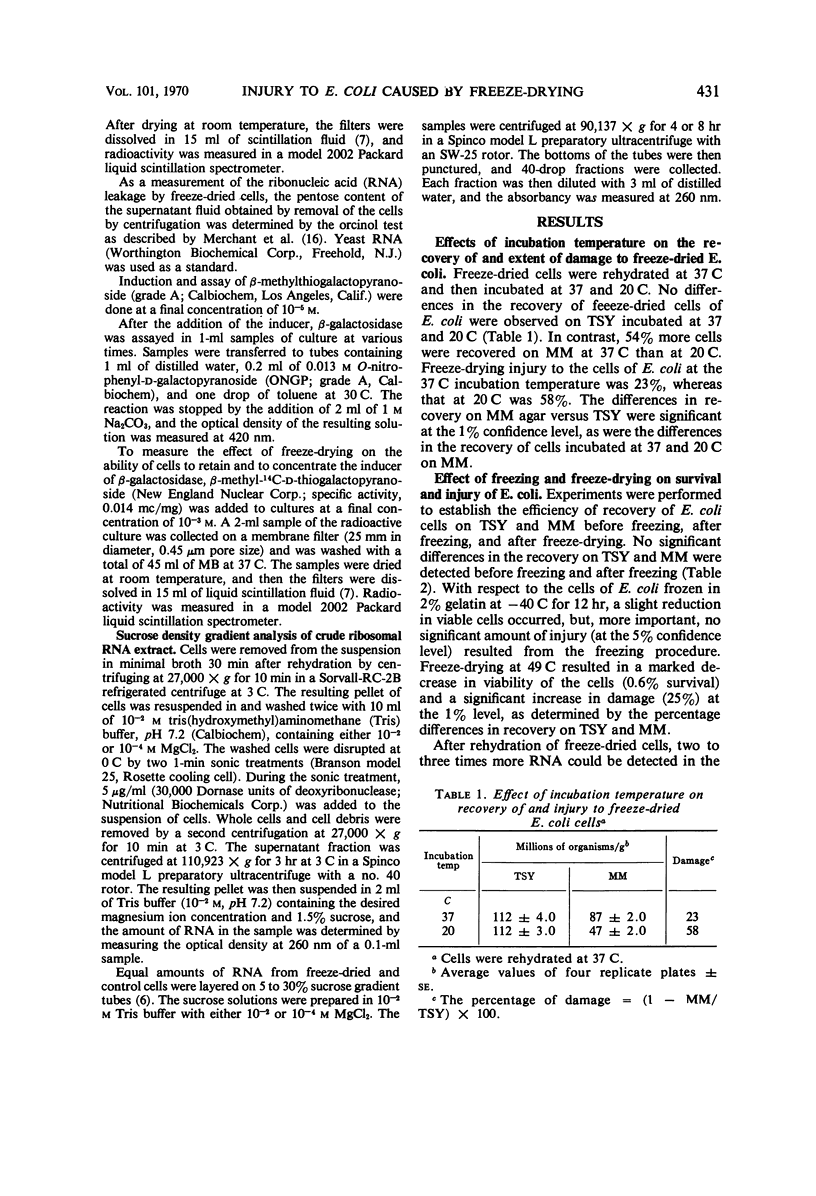
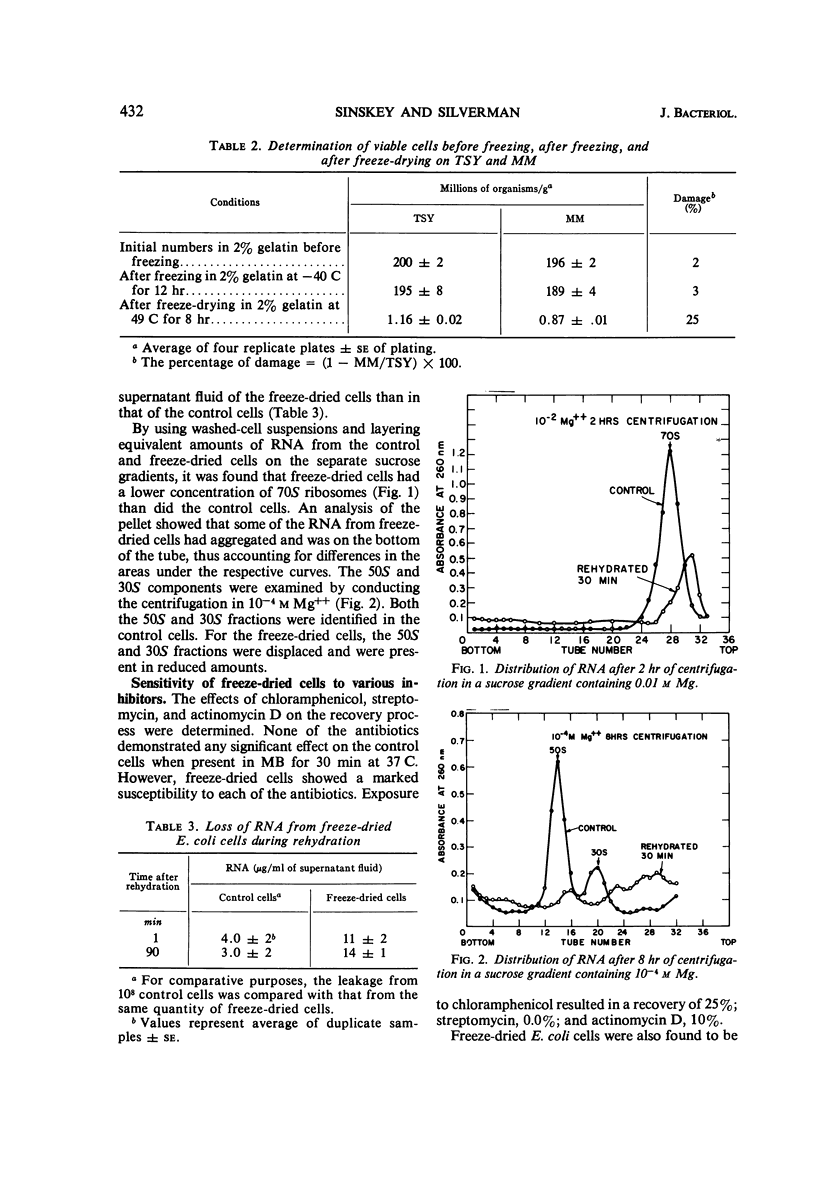
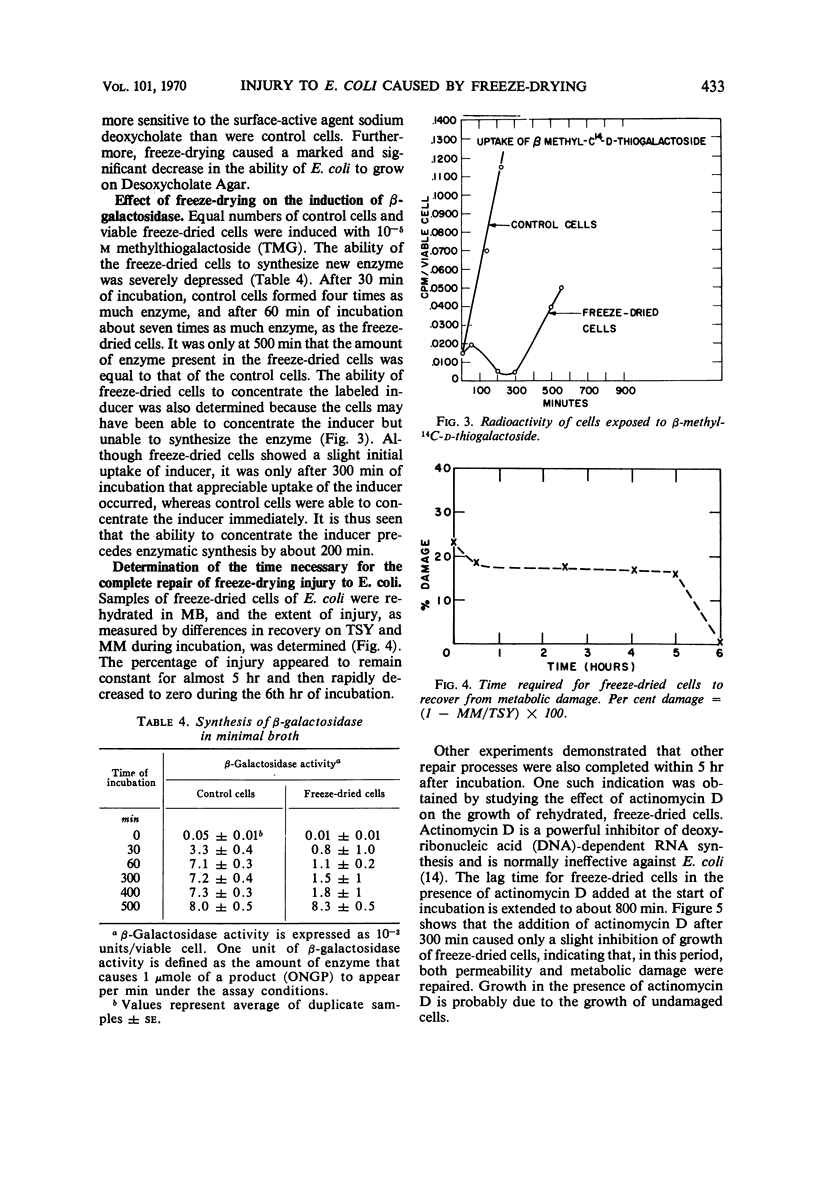
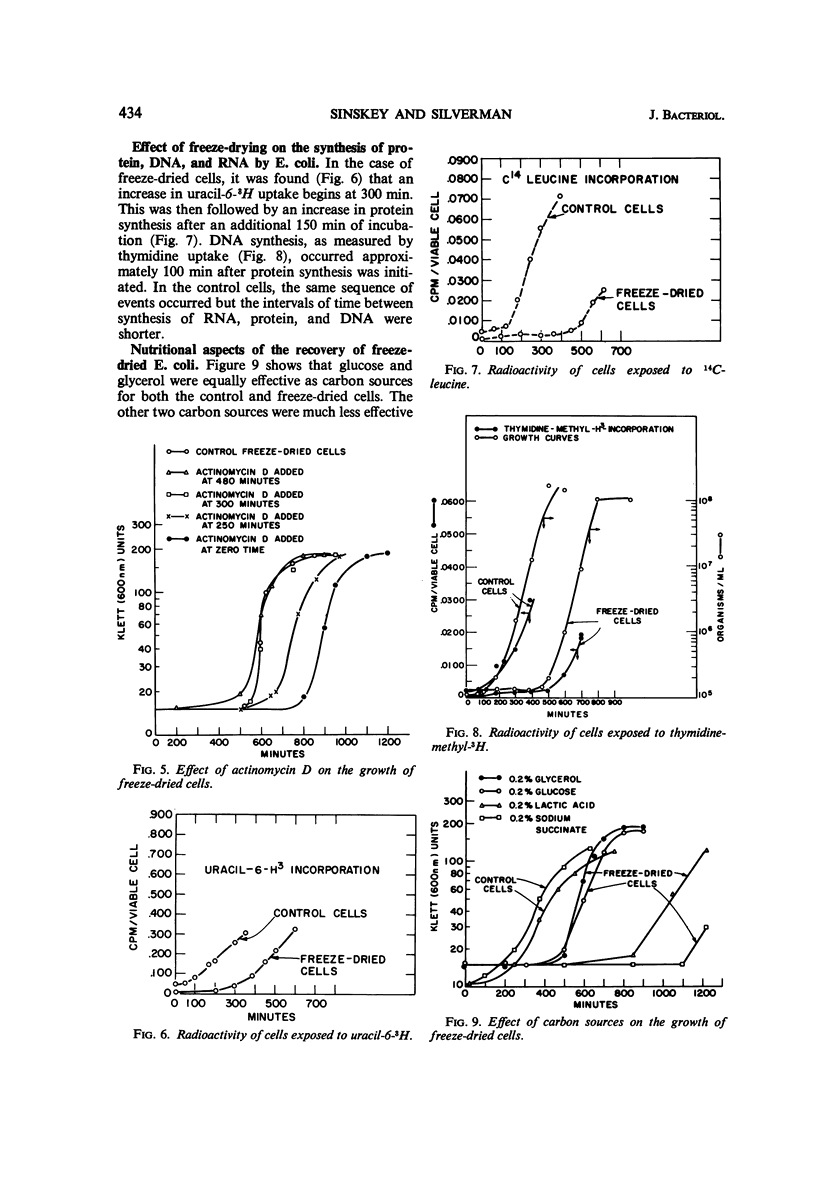
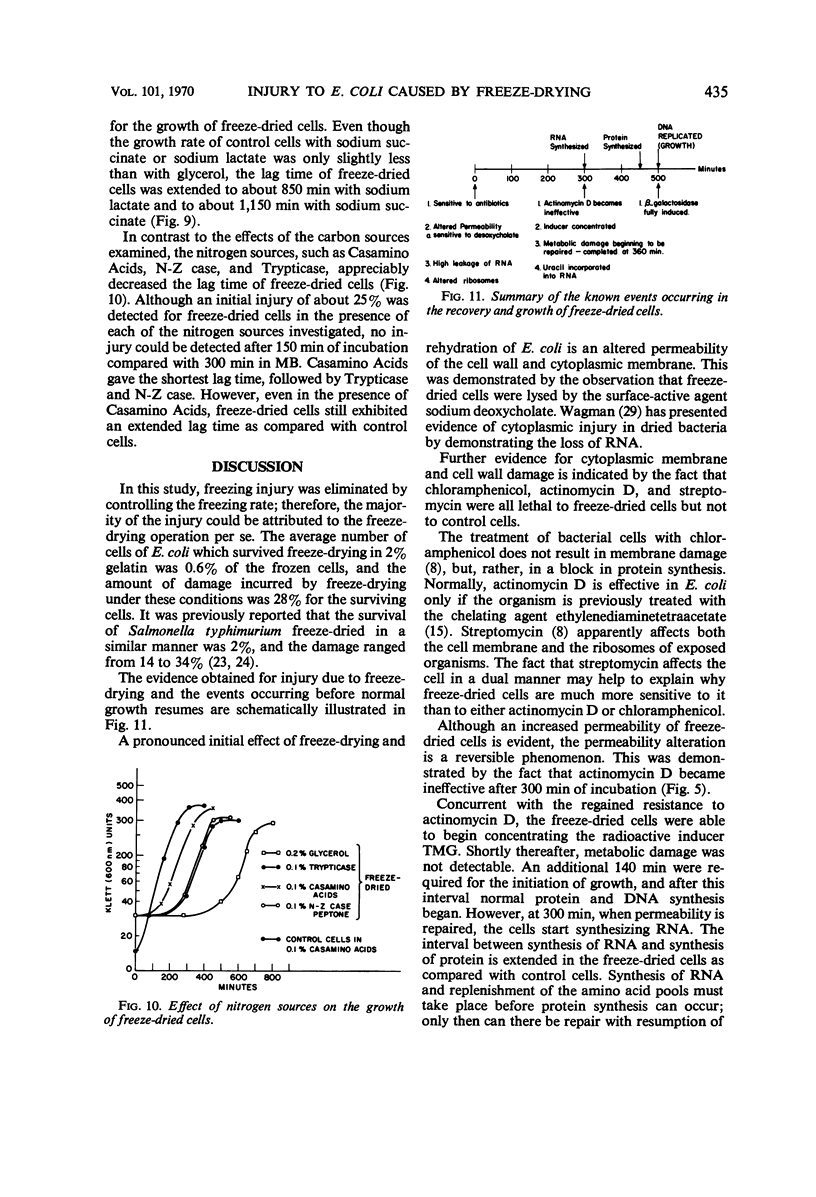
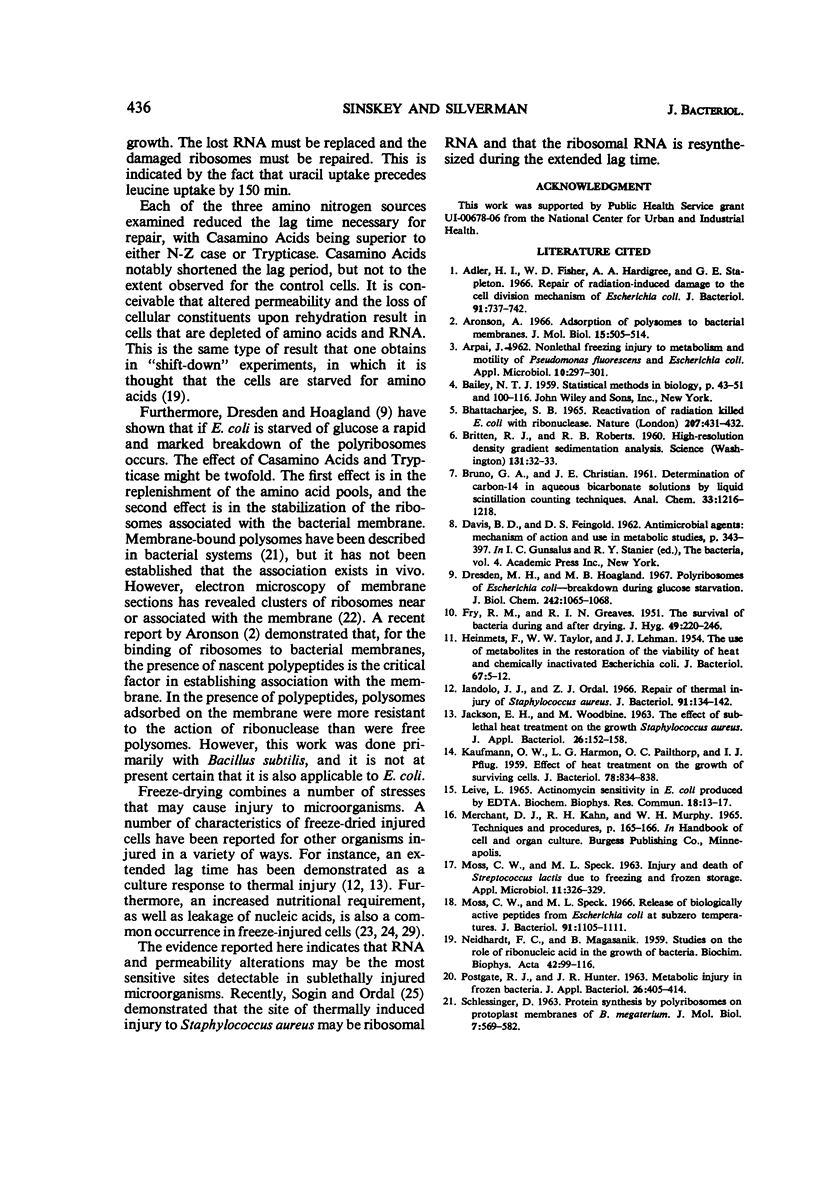
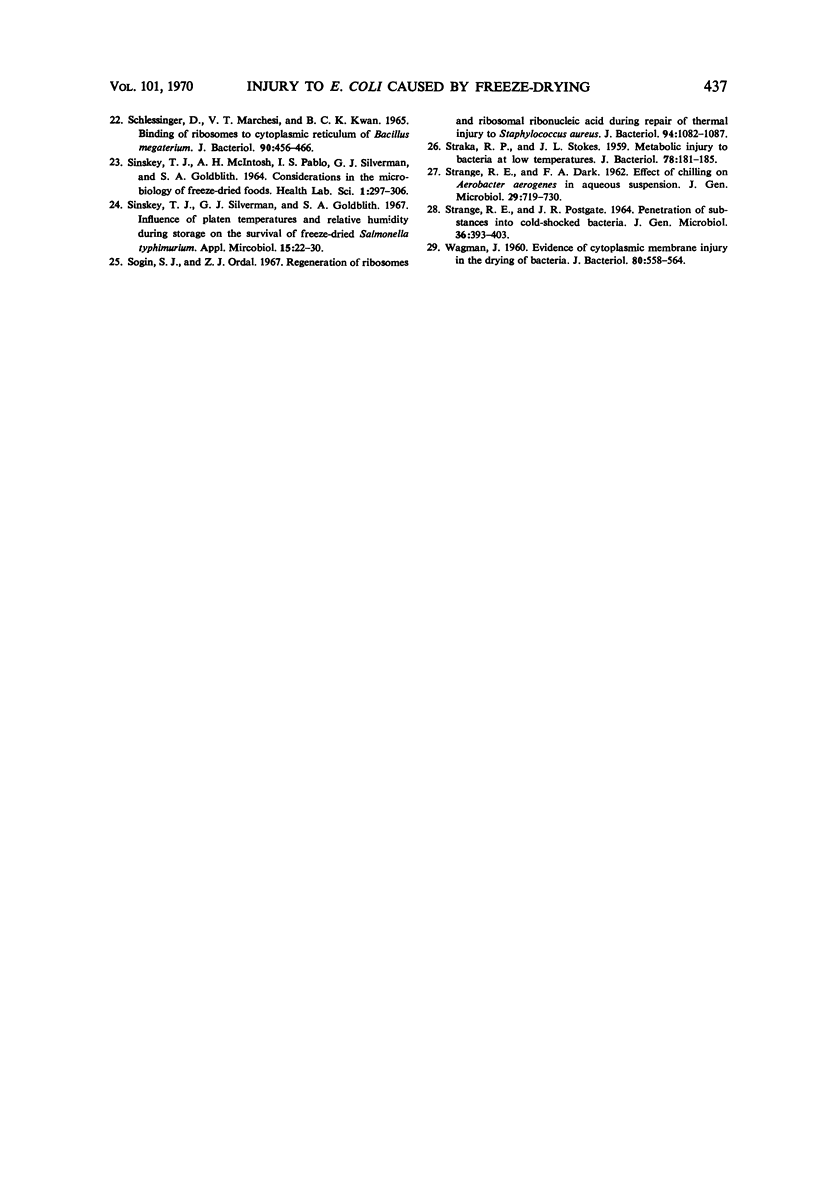
Selected References
These references are in PubMed. This may not be the complete list of references from this article.
- ARPAI J. Nonlethal freezing injury to metabolism and motility of Pseudomonas fluorescens and Escherichia coli. Appl Microbiol. 1962 Jul;10:297–301. doi: 10.1128/am.10.4.297-301.1962. [DOI] [PMC free article] [PubMed] [Google Scholar]
- Adler H. I., Fisher W. D., Hardigree A. A., Stapleton G. E. Repair of radiation-induced damage to the cell division mechanism of Escherichia coli. J Bacteriol. 1966 Feb;91(2):737–742. doi: 10.1128/jb.91.2.737-742.1966. [DOI] [PMC free article] [PubMed] [Google Scholar]
- Aronson A. Adsorption of polysomes to bacterial membranes. J Mol Biol. 1966 Feb;15(2):505–514. doi: 10.1016/s0022-2836(66)80124-9. [DOI] [PubMed] [Google Scholar]
- Bhattacharjee S. B. Reactivation of radiation-killed E. coli with ribonuclease. Nature. 1965 Jul 24;207(995):431–432. doi: 10.1038/207431a0. [DOI] [PubMed] [Google Scholar]
- Britten R. J., Roberts R. B. High-Resolution Density Gradient Sedimentation Analysis. Science. 1960 Jan 1;131(3392):32–33. doi: 10.1126/science.131.3392.32. [DOI] [PubMed] [Google Scholar]
- Dresden M. H., Hoagland M. B. Polyribosomes of Escherichia coli. Breakdown during glucose starvation. J Biol Chem. 1967 Mar 10;242(5):1065–1068. [PubMed] [Google Scholar]
- FRY R. M., GREAVES R. I. N. The survival of bacteria during and after drying. J Hyg (Lond) 1951 Jun-Sep;49(2-3):220–246. doi: 10.1017/s0022172400044120. [DOI] [PMC free article] [PubMed] [Google Scholar]
- HEIMETS F., TAYLOR W. W., LEHMAN J. J. The use of metabolites in the restoration of the viability of heat and chemically inactivated Escherichia coli. J Bacteriol. 1954 Jan;67(1):5–12. doi: 10.1128/jb.67.1.5-12.1954. [DOI] [PMC free article] [PubMed] [Google Scholar]
- Iandolo J. J., Ordal Z. J. Repair of thermal injury of Staphylococcus aureus. J Bacteriol. 1966 Jan;91(1):134–142. doi: 10.1128/jb.91.1.134-142.1966. [DOI] [PMC free article] [PubMed] [Google Scholar]
- KAUFMANN O. W., HARMON L. G., PAIL THORP O. C., PFLUG I. J. Effect of heat treatment on the growth of surviving cells. J Bacteriol. 1959 Dec;78:834–838. doi: 10.1128/jb.78.6.834-838.1959. [DOI] [PMC free article] [PubMed] [Google Scholar]
- LEIVE L. ACTINOMYCIN SENSITIVITY IN ESCHERICHIA COLI PRODUCED BY EDTA. Biochem Biophys Res Commun. 1965 Jan 4;18:13–17. doi: 10.1016/0006-291x(65)90874-0. [DOI] [PubMed] [Google Scholar]
- MOSS C. W., SPECK M. L. Injury and death of Streptococcus lactis due to freezing and frozen storage. Appl Microbiol. 1963 Jul;11:326–329. doi: 10.1128/am.11.4.326-329.1963. [DOI] [PMC free article] [PubMed] [Google Scholar]
- Moss C. W., Speck M. L. Release of biologically active peptides from Escherichia coli at subzero temperatures. J Bacteriol. 1966 Mar;91(3):1105–1111. doi: 10.1128/jb.91.3.1105-1111.1966. [DOI] [PMC free article] [PubMed] [Google Scholar]
- NEIDHARDT F. C., MAGASANIK B. Studies on the role of ribonucleic acid in the growth of bacteria. Biochim Biophys Acta. 1960 Jul 29;42:99–116. doi: 10.1016/0006-3002(60)90757-5. [DOI] [PubMed] [Google Scholar]
- SCHLESSINGER D., MARCHESTI V. T., KWAN B. C. BINDING OF RIBOSOMES TO CYTOPLASMIC RETICULUM OF BACILLUS MEGATERIUM. J Bacteriol. 1965 Aug;90:456–466. doi: 10.1128/jb.90.2.456-466.1965. [DOI] [PMC free article] [PubMed] [Google Scholar]
- SCHLESSINGER D. PROTEIN SYNTHESIS BY POLYRIBOSOMES ON PROTOPLAST MEMBRANES OF B. MEGATERIUM. J Mol Biol. 1963 Nov;7:569–582. doi: 10.1016/s0022-2836(63)80103-5. [DOI] [PubMed] [Google Scholar]
- STRAKA R. P., STOKES J. L. Metabolic injury to bacteria at low temperatures. J Bacteriol. 1959 Aug;78:181–185. doi: 10.1128/jb.78.2.181-185.1959. [DOI] [PMC free article] [PubMed] [Google Scholar]
- STRANGE R. E., DARK F. A. Effect of chilling on Aerobacter aerogenes in aqueous suspension. J Gen Microbiol. 1962 Dec;29:719–730. doi: 10.1099/00221287-29-4-719. [DOI] [PubMed] [Google Scholar]
- STRANGE R. E., POSTGATE J. R. PENETRATION OF SUBSTANCES INTO COLD-SHOCKED BACTERIA. J Gen Microbiol. 1964 Sep;36:393–403. doi: 10.1099/00221287-36-3-393. [DOI] [PubMed] [Google Scholar]
- Sinskey T. J., McIntosh A. H., Pablo I. S., Silverman G. J., Goldblith S. A. Considerations in the recovery of microorganisms from freeze-dried foods. Health Lab Sci. 1964 Oct;1(4):297–306. [PubMed] [Google Scholar]
- Sinskey T. J., Silverman G. J., Goldblith S. A. Influence of platen temperatures and relative humidity during storage on the survival of freeze-dried Salmonella typhimurium. Appl Microbiol. 1967 Jan;15(1):22–30. doi: 10.1128/am.15.1.22-30.1967. [DOI] [PMC free article] [PubMed] [Google Scholar]
- Sogin S. J., Ordal Z. J. Regeneration of ribosomes and ribosomal ribonucleic acid during repair of thermal injury to Staphylococcus. J Bacteriol. 1967 Oct;94(4):1082–1087. doi: 10.1128/jb.94.4.1082-1087.1967. [DOI] [PMC free article] [PubMed] [Google Scholar]
- WAGMAN J. Evidence of cytoplasmic membrane injury in the drying of bacteria. J Bacteriol. 1960 Oct;80:558–564. doi: 10.1128/jb.80.4.558-564.1960. [DOI] [PMC free article] [PubMed] [Google Scholar]


